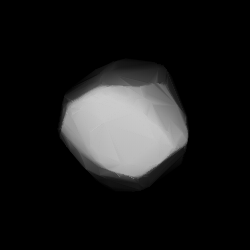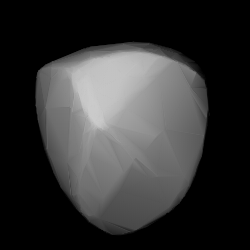Related Research Articles
1509 Esclangona, provisional designation 1938 YG, is a rare-type Hungaria asteroid and binary system from the inner regions of the asteroid belt, approximately 8 kilometers in diameter. It is named after French astronomer Ernest Esclangon.

2001 Einstein is a bright Hungaria asteroid from the innermost region of the asteroid belt. It was discovered by Swiss astronomer Paul Wild at Zimmerwald Observatory near Bern, Switzerland, on 5 March 1973. The X-type asteroid (Xe) has a rotation period of 5.5 hours and measures approximately 5 kilometers in diameter. It is named after physicist Albert Einstein (1879–1955).
1019 Strackea, provisional designation 1924 QN, is a stony Hungaria asteroid of the inner asteroid belt, approximately 8 kilometers in diameter. It was discovered on 3 March 1924, by astronomer Karl Reinmuth at Heidelberg Observatory in southwest Germany. It is named for German astronomer Gustav Stracke.
1203 Nanna is a carbonaceous asteroid from the outer region of the asteroid belt, about 35 kilometers in diameter. It was discovered on 5 October 1931, by German astronomer Max Wolf at Heidelberg Observatory in southwest Germany, and named after Anna Risi, a model and mistress of painter Anselm Feuerbach.

1042 Amazone, provisional designation 1925 HA, is a dark asteroid and slow rotator in the outer asteroid belt, approximately 70 kilometers in diameter. It was discovered on 22 April 1925, by German astronomer Karl Reinmuth at Heidelberg Observatory in southern Germany. It is named after the Amazons from Greek mythology.
1453 Fennia, provisional designation 1938 ED1, is a stony Hungaria asteroid and synchronous binary system from the innermost regions of the asteroid belt, approximately 7 kilometers in diameter. Discovered by Yrjö Väisälä at the Turku Observatory in 1938, the asteroid was later named after the Nordic country of Finland. The system's minor-planet moon was discovered in 2007. It has a derived diameter of 1.95 kilometers and is orbiting its primary every 23.55 hours.
3915 Fukushima, provisional designation 1988 PA1, is a carbonaceous asteroid from the inner regions of the asteroid belt, approximately 21 kilometers in diameter.
1177 Gonnessia, provisional designation 1930 WA, is a dark background asteroid from the outer regions of the asteroid belt, approximately 99 kilometers in diameter. It was discovered on 24 November 1930, by French astronomer Louis Boyer at the Algiers Observatory in Algeria, North Africa, and named after astronomer François Gonnessiat.
3353 Jarvis, or by its provisional designation, 1981 YC, is a carbonaceous Hungaria asteroid, slow rotator and suspected tumbler from the inner regions of the asteroid belt, approximately 10 kilometers in diameter.

1694 Kaiser is a carbonaceous background asteroid from the inner regions of the asteroid belt, approximately 16 kilometers in diameter. It was discovered on 29 September 1934, by Dutch astronomer Hendrik van Gent at Leiden Southern Station, annex to the Johannesburg Observatory in South Africa. It is named for Dutch astronomer Frederik Kaiser.

1987 Kaplan, provisional designation 1952 RH, is a stony Phocaea asteroid from the inner regions of the asteroid belt, approximately 14 kilometers in diameter. It was discovered on 11 September 1952, by Soviet astronomer Pelageya Shajn at the Simeiz Observatory on the Crimean peninsula. The asteroid was named after Soviet astrophysicist Samuil Kaplan.
1176 Lucidor, provisional designation 1930 VE, is a carbonaceous background asteroid from the central region of the asteroid belt, approximately 30 kilometers in diameter. It was discovered by Eugène Delporte in 1930, who named it after a friend.

2204 Lyyli is a dark asteroid and very eccentric Mars-crosser from the middle region of the asteroid belt, approximately 25 kilometers in diameter. It was discovered on 3 March 1943 by Finnish astronomer Yrjö Väisälä at Turku Observatory in Southwest Finland.
1626 Sadeya is a stony Phocaea asteroid and binary system from the inner regions of the asteroid belt, approximately 15 kilometers in diameter. It was discovered on 10 January 1927, by Catalan astronomer Josep Comas i Solà at Fabra Observatory in Barcelona, Spain, and named after the Spanish and American Astronomical Society. The discovery of a companion was announced on 1 December 2020.
2074 Shoemaker, provisional designation 1974 UA, is a stony Hungaria asteroid, Mars-crosser and suspected synchronous binary system from the innermost regions of the asteroid belt, approximately 4 kilometers in diameter. It was discovered on 17 October 1974, by astronomer Eleanor Helin at the Palomar Observatory. She named it after American astronomer Eugene Shoemaker.
For other uses, see Steel (disambiguation).
1656 Suomi is a binary Hungaria asteroid and sizable Mars-crosser from the innermost regions of the asteroid belt. It was discovered on 11 March 1942, by Finnish astronomer Yrjö Väisälä at Turku Observatory in Southwest Finland, who named it "Suomi", the native name of Finland. The stony asteroid has a short rotation period of 2.6 hours and measures approximately 7.9 kilometers in diameter. In June 2020, a companion was discovered by Brian Warner, Robert Stephens and Alan Harris. The satellite measures more than 1.98 kilometers in diameter, about 26% of the primary, which it orbits once every 57.9 hours at an average distance of 30 kilometers.
4142 Dersu-Uzala, provisional designation 1981 KE, is a Hungaria asteroid, sizable Mars-crosser and potentially slow rotator from the innermost region of the asteroid belt, approximately 6 kilometers in diameter. It was discovered by Czech astronomer Zdeňka Vávrová at Kleť Observatory on 28 May 1981. The rare A-type asteroid has a rotation period of 140 hours. It was named after the Siberian trapper and hunter Dersu Uzala.

1600 Vyssotsky, provisional designation 1947 UC, is a rare-type Hungaria asteroid and suspected interloper from the inner regions of the asteroid belt, approximately 7 kilometers in diameter. It was discovered on 22 October 1947, by American astronomer Carl Wirtanen at Lick Observatory in California, United States. It was named after astronomer Alexander Vyssotsky.
(6382) 1988 EL is a stony Hungaria asteroid from the inner regions of the asteroid belt, approximately 5 kilometers in diameter. It was discovered on 14 March 1988, by American astronomer Jeffrey Alu at the U.S. Palomar Observatory, California.
References
- 1 2 3 4 5 6 "JPL Small-Body Database Browser: 3873 Roddy (1984 WB)" (2017-05-05 last obs.). Jet Propulsion Laboratory . Retrieved 4 July 2017.
- 1 2 3 Schmadel, Lutz D. (2007). "(3873) Roddy". Dictionary of Minor Planet Names – (3873) Roddy. Springer Berlin Heidelberg. p. 329. doi:10.1007/978-3-540-29925-7_3862. ISBN 978-3-540-00238-3.
- 1 2 3 "3873 Roddy (1984 WB)". Minor Planet Center. Retrieved 25 March 2016.
- 1 2 3 4 5 6 "LCDB Data for (3873) Roddy". Asteroid Lightcurve Database (LCDB). Retrieved 25 May 2016.
- 1 2 3 4 5 Warner, Brian D. (January 2013). "Rounding Up the Unusual Suspects". The Minor Planet Bulletin. 40 (1): 36–42. Bibcode:2013MPBu...40...36W. ISSN 1052-8091. PMID 32455349 . Retrieved 1 March 2016.
- 1 2 3 Nugent, C. R.; Mainzer, A.; Masiero, J.; Bauer, J.; Cutri, R. M.; Grav, T.; et al. (December 2015). "NEOWISE Reactivation Mission Year One: Preliminary Asteroid Diameters and Albedos". The Astrophysical Journal. 814 (2): 13. arXiv: 1509.02522 . Bibcode:2015ApJ...814..117N. doi:10.1088/0004-637X/814/2/117 . Retrieved 5 December 2016.
- 1 2 3 4 Usui, Fumihiko; Kuroda, Daisuke; Müller, Thomas G.; Hasegawa, Sunao; Ishiguro, Masateru; Ootsubo, Takafumi; et al. (October 2011). "Asteroid Catalog Using Akari: AKARI/IRC Mid-Infrared Asteroid Survey". Publications of the Astronomical Society of Japan. 63 (5): 1117–1138. Bibcode:2011PASJ...63.1117U. doi: 10.1093/pasj/63.5.1117 . (online, AcuA catalog p. 153)
- 1 2 Warner, Brian D. (September 2006). "Asteroid lightcurve analysis at the Palmer Divide Observatory - late 2005 and early 2006". The Minor Planet Bulletin. 33 (3): 58–62. Bibcode:2006MPBu...33...58W. ISSN 1052-8091 . Retrieved 1 March 2016.
- 1 2 Klinglesmith, Daniel A. III; Hendrickx, Sebastian; Madden, Karl; Montgomery, Samuel (April 2016). "Lightcurves for Shape/Spin Models". The Minor Planet Bulletin. 43 (2): 123–128. Bibcode:2016MPBu...43..123K. ISSN 1052-8091 . Retrieved 5 December 2016.
- 1 2 Warner, Brian D. (June 2008). "Asteroid Lightcurve Analysis at the Palmer Divide Observatory - June - October 2007". The Minor Planet Bulletin. 35 (2): 56–60. Bibcode:2008MPBu...35...56W. ISSN 1052-8091 . Retrieved 1 March 2016.
- 1 2 Warner, Brian D. (October 2009). "Asteroid Lightcurve Analysis at the Palmer Divide Observatory: 2009 March-June". The Minor Planet Bulletin. 36 (4): 172–176. arXiv: 1203.4336 . Bibcode:2009MPBu...36..172W. doi:10.1016/j.pss.2012.03.009. ISSN 1052-8091 . Retrieved 1 March 2016.
- 1 2 Warner, Brian D. (January 2016). "Asteroid Lightcurve Analysis at CS3-Palmer Divide Station: 2015 June-September". The Minor Planet Bulletin. 43 (1): 57–65. Bibcode:2016MPBu...43...57W. ISSN 1052-8091. PMID 32455368 . Retrieved 1 March 2016.
- 1 2 3 Carry, B.; Solano, E.; Eggl, S.; DeMeo, F. E. (April 2016). "Spectral properties of near-Earth and Mars-crossing asteroids using Sloan photometry". Icarus. 268: 340–354. arXiv: 1601.02087 . Bibcode:2016Icar..268..340C. doi:10.1016/j.icarus.2015.12.047 . Retrieved 5 December 2016.
- ↑ Faure, Gerard; Garrett, Lawrence (October 2009). "Suggested Revised H Values of Selected Asteroids: Report Number 4". The Minor Planet Bulletin. 36 (4): 140–143. Bibcode:2009MPBu...36..140F. ISSN 1052-8091 . Retrieved 1 March 2016.
- ↑ Warner, Brian D. (April 2011). "Asteroid Lightcurve Analysis at the Palmer Divide Observatory: 2010 September-December". The Minor Planet Bulletin. 38 (2): 82–86. Bibcode:2011MPBu...38...82W. ISSN 1052-8091 . Retrieved 1 March 2016.
- ↑ "MPC/MPO/MPS Archive". Minor Planet Center. Retrieved 25 May 2016.